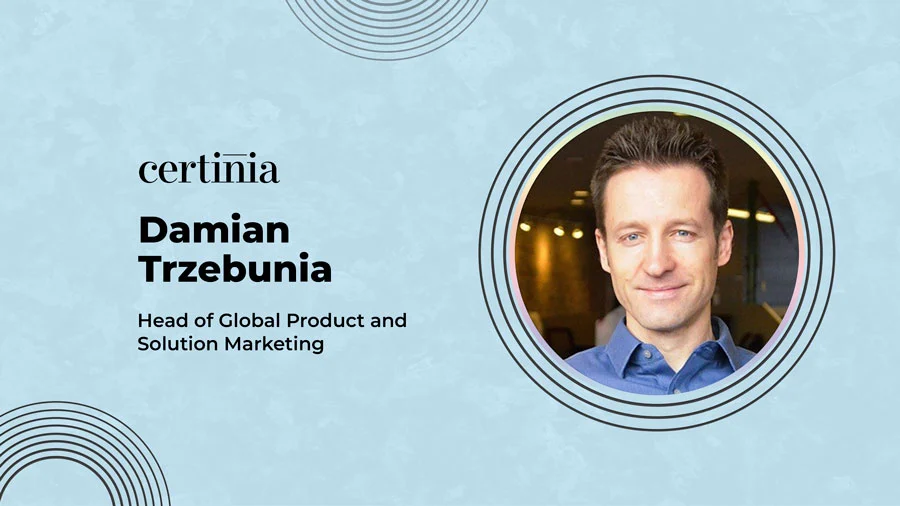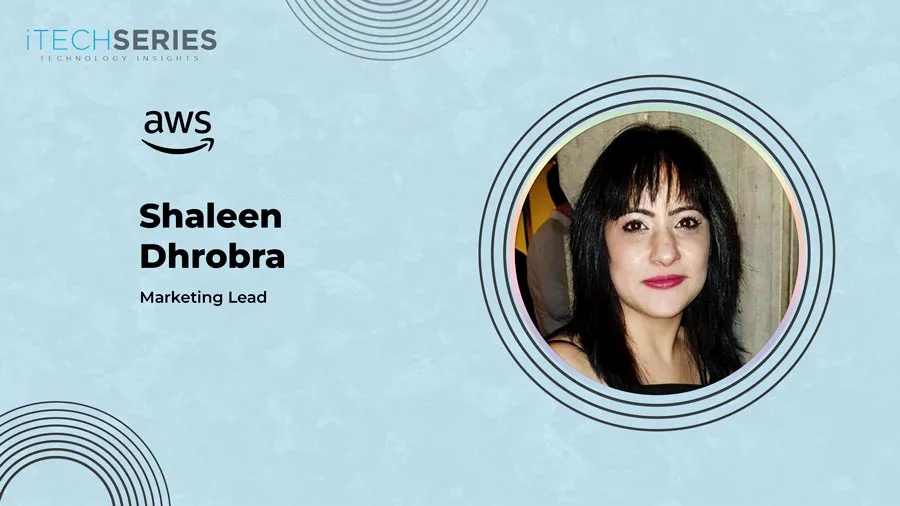Damian Trzebunia, Head of Global Product & Solution Marketing at Certinia, shares his journey, highlighting product marketing’s crucial role in strategy and growth. With 20+ years of experience, he discusses market rollouts, leveraging customer insights, crafting impactful GTM strategies, and building high-performing marketing teams.
It’s great having you for this interview, Damian. Tell us about your journey as a go-to-market leader.
Thank you; I appreciate the opportunity!
I’ve been in B2B SaaS marketing for 20 years, and I was fortunate very early in my career to find a niche within marketing that I felt passionate about, and that’s product marketing. I think of product marketing as the heart and soul of go-to-market activity. I spent the first 10+ years of my career in a variety of product marketing roles and settings, working with global cross-functional teams to take new offerings to market. That first phase of my career was largely about learning the craft, building a foundation, and gaining an appreciation for the impact that well constructed go-to-market strategies can have on a business and some of the challenges and pitfalls along the way.
For the last decade or so, I’ve been leading go-to-market strategy and global product marketing for progressively larger growth-stage and scale-up companies. This has given me the opportunity to lead and develop larger teams, manage more diverse product portfolios, and navigate challenging and very rewarding growth journeys mostly in the $50M to $500M in revenue range, including a few high profile exits. I’m currently in the process of finishing an MBA program in corporate entrepreneurship that captures my professional journey very well-helping proven companies find new levers for growth and scale. That’s really what go-to-market strategy and execution have been all about for me.
How have you approached the global rollout of product marketing strategies across diverse markets and portfolios?
It starts with understanding the customer and the market opportunity, including the different dynamics across market segments, industries, and regions. I think it’s important to assess the whole of the opportunity, but to then rationalize and prioritize the various go-to-market motions that could be activated to capitalize on that opportunity. And there’s no question that markets differ across segments and geographic regions. For example, leading a go-to-market program for a theme like supply chain (e.g., orchestrating more connected supply chains) will look different in Europe than it will in North America. That’s because priorities differ across continents, the regulatory climate is different, and what’s likely to resonate in a market message will differ.
Ultimately, it’s about understanding where you can have the biggest impact with the resources you have and the runway you’re given to achieve certain growth and revenue milestones. And this involves rationalizing the market opportunity and making choices (or placing bets). It’s also a lot like putting a puzzle together; the more pieces you have to work with, the more interesting it gets, and the more impact you can potentially have.
How has product marketing’s role evolved within an integrated revenue organization?
I think more is being asked of product marketers, which means the role can have a much bigger impact on pipeline and revenue. The reality is that most marketing and revenue teams face increasing pressure to evolve into a more efficient and scalable pipeline generating machine. And because product marketers are often the closest to the market, the message, and the customer, they have the orientation and the perspective to act as the connective tissue across marketing and go-to-market functions to orchestrate the right activity and help ensure that it lands well.
What’s different is that instead of building the go-to-market playbook and handing it off to demand generation and sales teams for execution, product marketers are pulling the thread all the way through to lead generation, deal progression, and revenue attainment and monitoring metrics to understand the impact, as well as using those insights to iterate on and fine-tune product marketing strategies. In that sense, product marketers are effectively becoming GTM operators, and that spells opportunity. Another way to think of it is that product marketers have a lane i.e. certain deliverables and processes for which they’re responsible, but there’s also this added dimension of conducting the go-to-market orchestra, which is where the magic is and where the real impact is felt.
As a marketing leader, how do you assess the state of product adoption in a region or market before planning a go-to-market program?
I make sure to spend time with customers, partners, analysts, sales leaders, industry publication thought leaders and other sources to understand the lay of the land and the dynamics at play. I think it’s important for marketing leaders to invest the time to form a point of view about a market opportunity.
It’s also worth noting that some things you need the market itself to tell you. Upfront research is important, but you also need to be intentional about engaging with the market, so you can start testing and iterating on your go-to-market approach and gauging the response and feedback from the market. I think many organizations get stuck on the analysis and building consensus internally; consequently, they wait too long to engage. Some answers can only be obtained by doing, and the way to get those insights is to start engaging and learning and then adapting your go-to-market program accordingly.
“I view the voice of the customer as an essential input because it provides the external market validation that you need to inform go-to-market strategies.”
What strategies have you found effective for positioning products in a crowded or saturated market?
In my experience, crafting a differentiated and memorable message that sparks an emotive connection with the buyer is both an art and a science. It starts with a well-informed point of view about the market you’re targeting, which involves a lot of research and some scientific rigor. Once you’ve done the research, both primary and secondary, you can then focus on being creative within those confines. In that sense, the science paves the way for the art.
I’m also a believer in blue ocean strategy and finding new uncontested market spaces. Red oceans are crowded and highly contested, yet it’s within those red oceans that untapped blue ocean opportunities exist. One of the most helpful insights I’ve come across regarding blue ocean strategy is that corporate strategy is heavily influenced by military strategy, which is all about red ocean competition i.e., working within limited terrain to defeat an enemy in order to succeed. By contrast, the blue ocean strategy taps into the business world’s capacity to create new market space that is uncontested.1
As a product marketing leader, how do you ensure that the voice of the customer is collected and used to further streamline go-to-market strategies?
I view the voice of the customer as an essential input because it provides the external market validation that you need to inform go-to-market strategies. Understanding the customer, identifying key pain points, crafting the right message, building a customer journey, and related offers, are all informed by the voice of the customer. Also, customer success stories and analyst reports that highlight leadership capabilities can serve as compelling offers to drive awareness, progress deals, and win in head-to-head scenarios.
One of the best ways to collect this insight is to invest in primary research. An example of this would be conducting an extensive survey and related interviews to understand how your target market approaches a given topic or trend. These results give you a platform on which to create thought leadership content to fuel and anchor your integrated campaigns. What you learn directly from customers and other constituents can also manifest in other elements of your go-to-market playbook, including foundational messaging, website copy, paid media efforts, sales enablement, and more.
In your opinion, what are the most critical elements of a successful go-to-market launch?
It’s paramount to have a clear objective and definition of success. So many go-to-market efforts lack clear goals and metrics, and that’s a recipe for failure. There needs to be alignment and consensus across functions because go-to-market launch is a team sport, and all stakeholders need to be vested and committed to the same goal and ready to execute.
As alluded to earlier, I also think it’s critical to understand the market you’re entering and the key dynamics so you can effectively position yourself to win. It’s also important to note that the devil is in the details, and you have to execute well. It’s possible to be dialed in to the right persona in the right market with the right message and offer but to fail to capture attention and drive engagement in the way you execute. The details matter, and it must be the best foot forward every time.
How do you measure the success of your marketing efforts and which key metrics do you keep an eye on?
It’s a mix of qualitative and quantitative metrics, but ultimately, it’s about ensuring a healthy pipeline, facilitating deal progression, and driving revenue attainment. Marketers live and die by the pipeline, and product marketing is no exception. The win rate for key competitors is also important, as are qualitative metrics around content engagement. Tracking brand awareness and engagement is also key; while it’s a softer metric that often gets deprioritized, it’s foundational to the success of the overall marketing effort.
What advice would you give to budding marketing leaders on building and managing high-performing marketing teams?
Two things come to mind. First, you have to hire well. As Warren Buffett famously remarked, “Hire well, manage little.” To attract the right talent, you need a clear idea of the right profile for your team, which goes beyond hiring for specific skills. For example, in growth-stage and scale-up companies, it’s crucial to hire people that have a growth mindset, are stimulated by possibility, and have an appetite for effecting change. With that profile in mind, the trick is to be able to pick up on those essential qualities in interactions with potential candidates.
Once you have the right talent, it’s then vital to create and nurture a sense of vision and purpose that can serve as your team’s anchor. High-growth environments are often messy and fraught, and you could easily bog down in process immaturity, unrealistic expectations, and ambiguity. This is why you need to establish higher ground where you and your team can come up for air and reconnect with your mission.
1 Kim, W. Chan, and Renée Mauborgne. “Blue Ocean Strategy.” Harvard Business Review, October, 2004.
Certinia, formerly FinancialForce, empowers technology and service organizations by providing a comprehensive Services-as-a-Business platform. This innovative solution connects all aspects of service operations, including estimation, delivery, customer success management, and financial planning. With a focus on optimized resource utilization, real-time insights, and compliance, Certinia enables businesses to enhance customer value and drive profitability. Recognized for its commitment to security and seamless collaboration, Certinia is designed to help organizations become agile, customer-centric entities in today’s fast-paced market.
Damian Trzebunia is a B2B SaaS marketing professional with 20 years of experience, specializing in go-to-market strategy and product marketing for growth-stage companies. He has held key positions at Appian and Brightly, where he successfully led marketing initiatives. With a strong background in corporate entrepreneurship, Damian excels at identifying growth opportunities and orchestrating global integrated marketing programs across diverse industries, including financial services and healthcare. He is passionate about team leadership, collaboration, and fostering customer-centric strategies.











